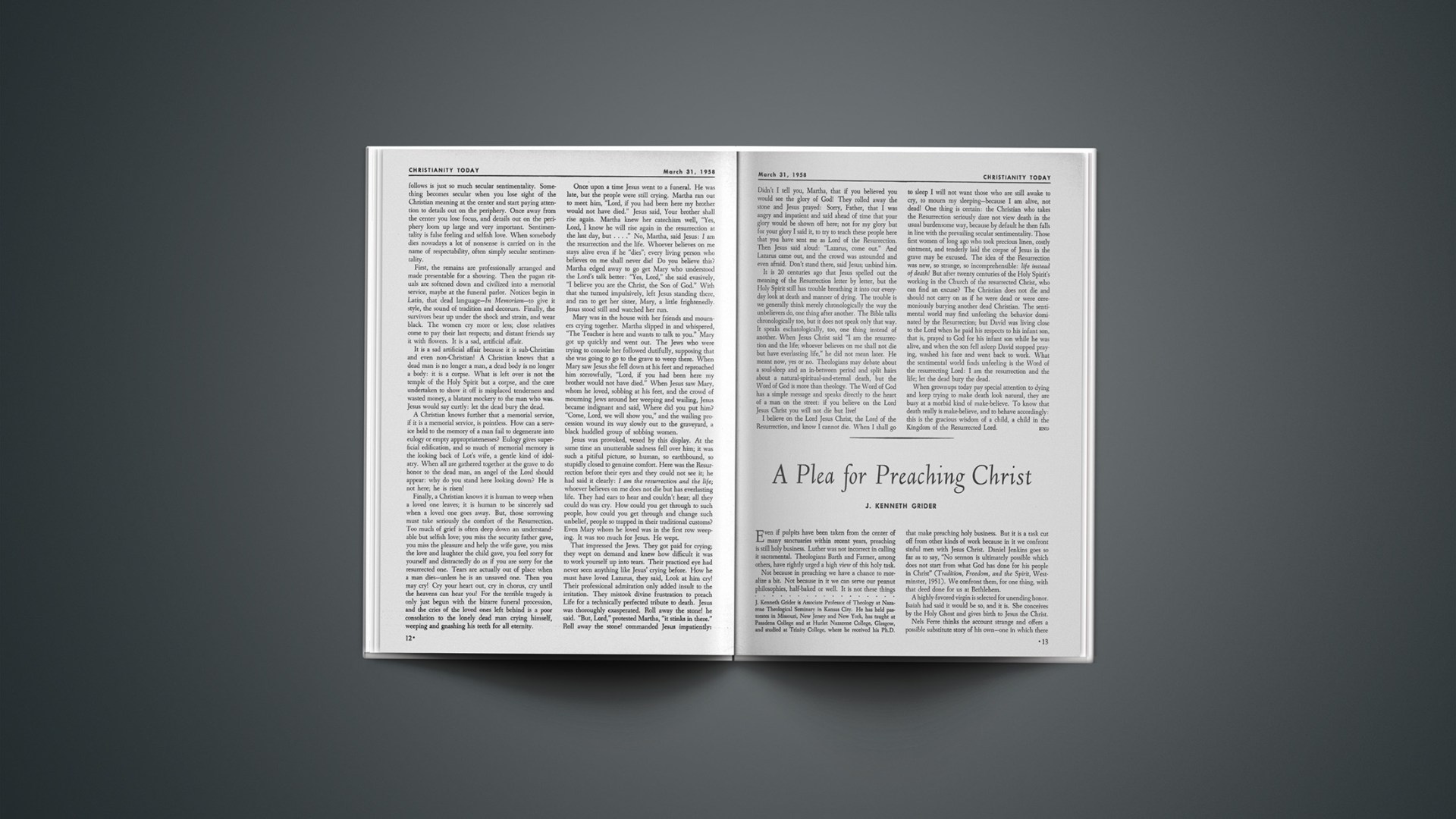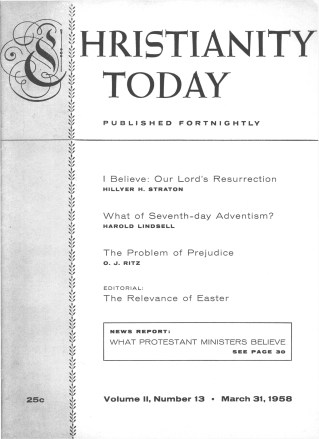Even if pulpits have been taken from the center of many sanctuaries within recent years, preaching is still holy business. Luther was not incorrect in calling it sacramental. Theologians Barth and Farmer, among others, have rightly urged a high view of this holy task.
Not because in preaching we have a chance to moralize a bit. Not because in it we can serve our peanut philosophies, half-baked or well. It is not these things that make preaching holy business. But it is a task cut off from other kinds of work because in it we confront sinful men with Jesus Christ. Daniel Jenkins goes so far as to say, “No sermon is ultimately possible which does not start from what God has done for his people in Christ” (Tradition, Freedom, and the Spirit, Westminster, 1951). We confront them, for one thing, with that deed done for us at Bethlehem.
A highly-favored virgin is selected for unending honor. Isaiah had said it would be so, and it is. She conceives by the Holy Ghost and gives birth to Jesus the Christ.
Nels Ferre thinks the account strange and offers a possible substitute story of his own—one in which there is no mystery, no miracle, not even a moral element. Brunner also quite denies the account in order to make room, as he says, for believing in the Incarnation by faith.
Yet in this way, through birth by a virgin, God entered into our humanity. By this means he got a footing on the hard earth by which to lift us out of sin. A heartbeat away—no more than that. That is how near the God of the Incarnation is to men. No other religion makes such a claim as this—that God was born into our world, a man among men; that he is even now touched by the agony of our infirmities.
At Pentecost, Peter established this “enmanment” before going on to tell of the death and Resurrection. And so did Stephen soon afterwards; and Paul, on numerous occasions.
One might not want to call this “the central affirmation of Christianity” as H. H. Farmer does. For one might not wish so to disjoin it from the death and Resurrection. For the same reason, one might not want to say with John S. Whale that Christianity is “a religion that finds its living heart in an Incarnation” (Christian Doctrine, Macmillan, 1942, p. 21). But it is certainly a central element of the kerygma. And it is appealing to men who feel distanced from God by reason of their sins and who have the jitters in this hydrogen era. Perhaps twentieth-century men are not so different from first-century men as Bultmann thinks. The common people hear Graham gladly; and that evangelist’s message is not a “demythologized” version of the apostolic preaching, but that kind of preaching in its first-century simplicity and power. But there is more.
The Death Of Christ
There they are, three of them. Not one, but three. Three men leave Pilate’s palace bearing crosses, trekking their last road. They are en route to a skull-like knoll outside a Jerusalem gate. Numbered with two transgressors, our Master submits himself to public shame along the holy streets.
It has been a strange trial. Our Lord’s accusers and his judges have been the same persons. An officer, during the proceedings, has been allowed to strike Jesus. Messengers, scurrying from home to home in the darkness, have got the Sanhedrinists into a night session, contrary to their rules, and that body has made its decision against Jesus when a sleeping populace could not become aroused.
Jesus was to die, but the holy Sanhedrin could not make such sentence. So they pressured Pilate to do it for them. Pilate had finally produced Jesus, robed, thorn-crowned and beaten bloody, before the murderous mob and let them go on with their sin. Those who had thirsted for his death had triumphed. And Jesus made his way to Golgotha and died for us.
O what wonder—what sweet wonder! Love without limit; mercy without measure; suffering without stint. Pile them all on there—words like propitiation, sin offering, sacrifice, ransom, free gift. And then put on some more—like obedience, surrender, sorrow, affliction. Still you cannot describe it; you are only hinting at its strength with the weakness of words.
Always some have wagged their heads, unable to see it. A man reveals God—how can it be? One dies for all—instead of all! Redemption is provided! The law of karma they could see, but not lawless forgiveness. Works they could figure out, but not grace. A bloody religion, that’s all, with a murder at its middle. To the Jews a stumbling block and to the wise ones foolishness. O the offense, the scandal of it all!
But wait! Its secret does get out. Young and old do believe. Even if it opposes what a rationalist would figure out, it is true after all. The blind do see and the lame walk. Sinners are transfigured. And God puts a glory in their souls, a song in their hearts, a word of witness on their tongues, and a map—a world map—in their hands. They fan out in every direction, to every part. For they cannot but speak of something so utterly real to them.
Such as this is a scoop, sure enough. It is big news and must be told—front page, headline, byline and all. Our listeners hear from Moscow and London and Washington through men appointed for that work. Come Sunday they need to hear—they must hear—from Calvary. But there is more. Much more.
Hope had grown corpse-cold for the apostles. Bewildered, disillusioned, morbid in memories—it was the end. What was left for them? Fishing, perhaps; certainly chagrin. Had not their Lord been crucified on a Roman cross and buried?
Entombed and sealed in, with a heavy stone rolled against the door and an armed guard sitting about, Jesus had had a seeming checkmate. Yet he vacated that tomb and became the perennial contemporary.
The Resurrection Theme
To a man the New Testament writers believed he had risen. Of that event James Stewart writes, “This was indeed the very core of the apostolic kerygma.… It was the theme of every Christian sermon; it was the master motive of every act of Christian evangelism; and not one line of the New Testament was written … apart from the conviction that he of whom these things were written had conquered death and was alive forever” (A Faith to Proclaim, pp. 104, 105).
Had he not appeared to the Marys and Salome? to those two disheartened ones along the country road there; to the eleven; to above five hundred; and later to Saul, man-eating tiger from Tarsus? Certainly he had. And many blessed ones on through history’s jaunts have believed, not having “seen” in that same way. The Sadducees have had no continuing citadel!
It means something to them, too. He indwells them. And they take assurance with what they find in Hosea: “O death, I will be thy plagues.…” (13:14). Because he lives, they will live also—abundantly here, and aboundingly there.
The Resurrection packed the Incarnation and the death chock-full with continuing meaning. It is integral to the whole redemptional scheme. So with that footing in history and with the smashing by men bent on sin, this enlivening has to be told. “Go … tell …” was the commission to those first women witnesses. Surely that is the word also to the Christ announcers in our time.
Nothing Less Than Gospel
A now tottering liberalism taught that man is inherently good, a god writ small—that there is nothing wrong with him that “a little bicarbonate of soda wouldn’t take care of” (Bulkley, Christian Century, Nov. 21, 1956). Walter Rauschenbusch took that sort of view in his earlier works, but made a distinct change by 1917 in his lectures at Yale, A Theology for the Social Gospel.
Others too, such as Karl Barth, have made an about-face, so that now most will agree with Edwin Lewis that there is a radical disharmony at man’s center. It is true that the new doctrines of man’s sinfulness are in modern dress. For example, many join with Reinhold Niebuhr in denying that the Fall was historical. Yet it all means that modern man is facing up to his sinfulness—to the built-in kind and the kind you obtain later. To us who preach it means that we can never simply moralize any more, for that might further entrench sinners in their smugness. It will take no less than the preaching of the Gospel of Christ, “which is the power of God unto salvation to every one who believes.”
J. Kenneth Grider is Associate Professor of Theology at Nazarene Theological Seminary in Kansas City. He has held pastorates in Missouri, New Jersey and New York, has taught at Pasadena College and at Hurlet Nazarene College, Glasgow, and studied at Trinity College, where he received his Ph.D.










